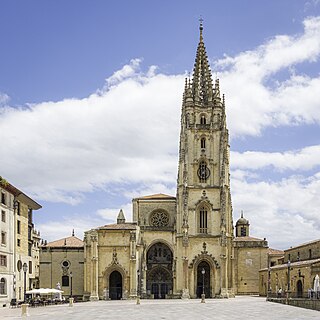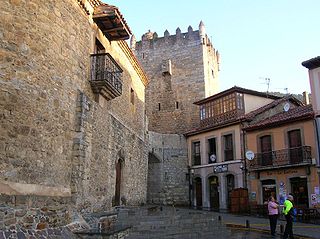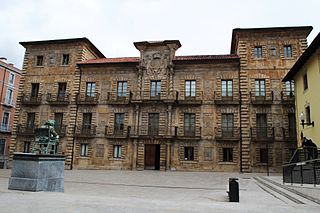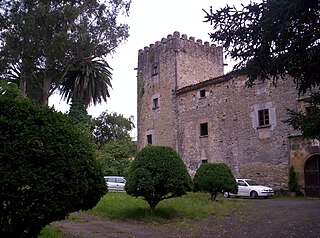Related Research Articles

Boal is a municipality, a civil parish and a town in the Autonomous Community of the Principality of Asturias (Spain). It borders north with El Franco and Coaña, south with Illano, west with Castropol and east with Villayón.

The Metropolitan Cathedral Basilica of the Holy Saviour or Cathedral of San Salvador is a Roman Catholic church and minor basilica in the centre of Oviedo, in the Asturias region of northern Spain.

The Monastery of Santo Toribio de Liébana is a Roman Catholic monastery located in the district of Liébana, near Potes in Cantabria, Spain. Located in the Cantabrian Mountains in northern Spain, the monastery is one of the five places in Roman Catholicism, together with Rome, Jerusalem, Santiago de Compostela and Caravaca de la Cruz, that has the privilege of issuing perpetual indulgences.

Pre-Romanesque architecture in Asturias is framed between the years 711 and 910, the period of the creation and expansion of the kingdom of Asturias.

El Franco is a municipality in the autonomous community of the Principality of Asturias. It is bordered on the north by the Cantabrian Sea, to the west by Tapia, to the south by Castropol and Boal, and to the east by Cuaña. El Franco is part of the comarca of Eo-Navia.

Castel Nuovo, often called Maschio Angioino, is a medieval castle located in front of Piazza Municipio and the city hall in central Naples, Campania, Italy. Its scenic location and imposing size makes the castle, first erected in 1279, one of the main architectural landmarks of the city. It was a royal seat for kings of Naples, Aragon and Spain until 1815.

The Castillo de Salas is a castle in the town of Salas in the region of Asturias, northern Spain. It first appeared in documentation in 1124.
The Berdín Palace is located in the village of Doiras, in Boal, Asturias, Spain.

The Lerma Ducal Palace is the palace of the dukes of Lerma in Lerma (Burgos) in Spain, occupying the whole of one side of the city's Plaza. Originally it had immense gardens below it, on the banks of the river, with fountains, stately homes and seven chapels, of which one (Cristo) remains. All documents relating to its construction have been conserved. A 17th-century work, building started in 1601 under commission from Francisco Gómez de Sandoval y Rojas, Duke of Lerma. Its architect was Francisco de Mora and is it is considered de Mora's masterwork and one of the finest buildings of that era.

The Holy chamber of Oviedo is a Roman Catholic pre-Romanesque church in Oviedo, Spain, built next to pre-romanesque Tower of San Miguel of the city's cathedral. Nowadays, the church occupies the angle between the south arm of the cathedral transept and a side of the cloister.

The Church of San Jorge of Manzaneda is a church in Gozón, Spain. It is small in size, but it constitutes a notable example of Asturian Romanesque architecture. It was created during the classical period in the late 12th and early 13th centuries. It is small in size and significant for its architecture and its surrounding environment which has barely changed.

The Church of San Martín de Luiña is a Baroque-style Roman Catholic parish church located in Escalada in Asturias, Spain. The building, located at the top of the hill, is surrounded by the residential areas of Escalada. The current church, begun in 1718, was completed in 1726, according to the inscription on the lintel of the door.

The Palace of Cienfuegos de Peñalba arises on a hill near Pola de Allande, capital of the Allande Municipality of Asturias, Spain. It was originally built in the 15th century on the site of an ancient fort, but has been refurbished so that the only remaining Gothic elements are on the lowest level.

Balsera Palace or Sendón is located in the town of Avilés in Asturias, Spain. Formerly a private residence, it now houses the Julián Orbón Municipal Conservatory of Music.

The Gobiendes Palace is a palace located in the municipality of Colunga, Asturias, Spain. It was built with a medieval tower in the 15th century, and belonged to the Mitra Ovetense until the time of Philip II, who sold it to Gonzalo Ruiz de Junco. The building was later extended, and today it has two perpendicular wings, with a side chapel.

Camposagrado Palace is a baroque-style palace located in Avilés in Asturias, Spain. It was constructed on the site of a medieval building and used by the family of the Marquises of Camposagrado until the nineteenth century when it became a military barracks. In the twentieth century, the property was partially used for commercial purposes, but after acquisition and restoration by the City Council of Avilés, it became the School of Art for the Principality of Asturias.

Díaz Inguanzo Palace is located in the parish of Berodia, in the municipality of Cabrales, in Asturias, Spain. The palace is in a valley, near the Iglesia de Sta. María Magdalena and a few hundred meters from the town.

Doriga Palace is located in Salas, Asturias, Spain. It is an example of a structure built for nobility, half containing a defensive character, and the other half being residential. The original nucleus is a medieval square tower, built in the 14th century, which forms part of the current palace. In the 15 century, a cubic structure was added to the tower. Its present aspect was completed during the early years of the 16th century, centered on the palace section.

The Palace of the Convent of San Francisco or Palace of the ex-Convent of San Francisco is a former medieval Nasrid palace in the Alhambra of Granada, Spain, which was transformed into a Franciscan convent after the Spanish conquest of Granada. By the early 20th century it had fallen into ruins and it was significantly restored under the direction of Leopoldo Torres Balbás in the 1920s. Since 1945, it serves as a state-owned Parador hotel.

The Markeskua Palace, also known as the Tower of Isasi or Palace of the Marquis of Isasi, is a renaissance noble house located in the Basque town of Eibar (Spain).
References
- ↑ Braña, Alejandro (2023-04-14). "Palacio de Prelo en Boal". Asturias por Descubrir (in Spanish). Retrieved 2024-05-06.